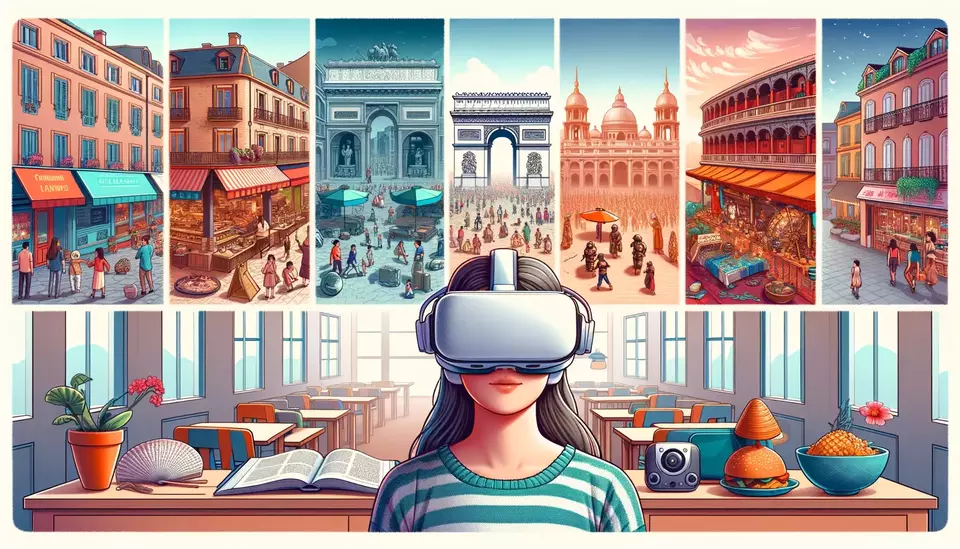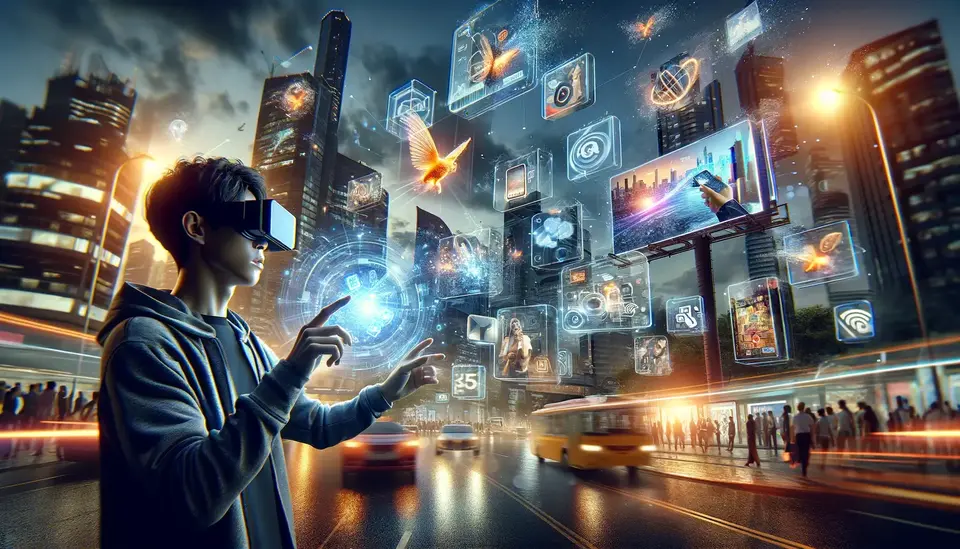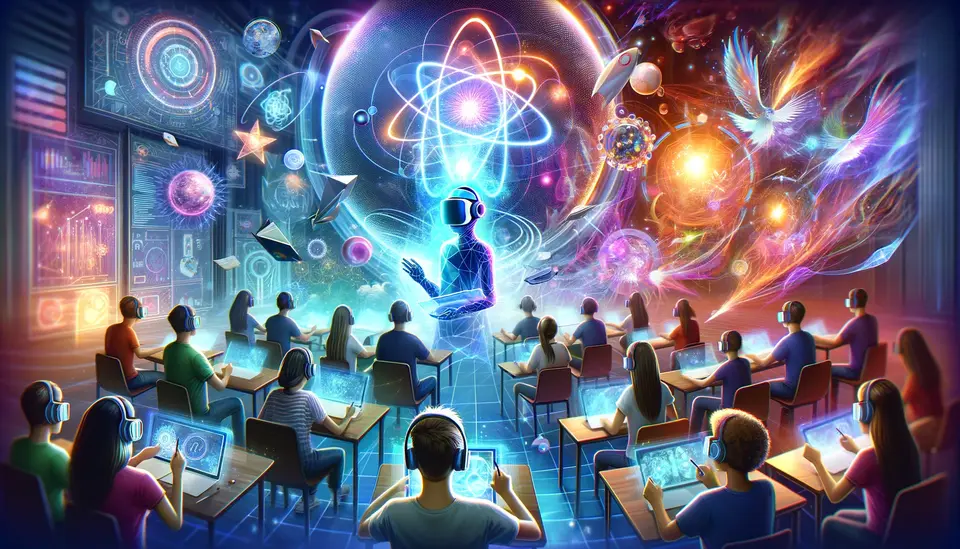How to learn languages with Virtual Reality (VR)?
Posted on October 26, 2023 12 minutes 2411 words
Table of contents
- Introduction
- 1. The Science Behind VR and Language Acquisition
- 2. Benefits of Using VR for Language Learning
- 3. Popular VR Language Learning Applications
- 4. How to Get Started with VR Language Learning
- 5. Tips for Effective VR Language Learning
- 6. Overcoming Challenges in VR Language Learning
- Conclusion
Introduction
In our rapidly evolving technological landscape, many innovations initially designed for entertainment have found profound applications in more serious spheres. A prime example of this shift is Virtual Reality (VR), which has transcended its gaming roots to revolutionize various fields, especially education.
Virtual Reality (VR): Beyond Gaming to Education
Virtual Reality (VR) technology, once primarily the realm of video games and entertainment, has expanded its horizon into myriad sectors, notably including education. Over the past few years, there has been a significant uptick in educational institutions and software developers embracing VR to provide immersive learning experiences. This powerful tool can transport students to different eras in history, offer a front-row seat to intricate biological processes, and even allow them to converse in a foreign language as if they were in a country where it’s spoken natively.
The Power of Immersive Language Learning
One of the standout applications of VR in education is language acquisition. Traditional methods of learning a new language, while effective, often lack the context and real-life interaction crucial for genuine fluency. With VR, learners are no longer bound by the limitations of textbooks or classroom walls. Instead, they are immersed in virtual environments where they can hear, respond, and interact using their target language. This immersive method doesn’t just teach the language; it provides a multi-sensory experience of the culture, context, and nuances that come with it. As the old saying goes, “To learn a language is to have one more window from which to view the world.” VR, in this sense, provides a panoramic view.
Thus, as technology continues to break barriers, the domain of language learning is undergoing a paradigm shift. VR’s capability to create lifelike, immersive experiences ensures that learners not only understand a language’s structure but also its soul, culture, and context, truly epitomizing the idea of learning as a gateway to the world.
1. The Science Behind VR and Language Acquisition
While the allure of Virtual Reality (VR) in education is palpable, it’s essential to delve into the underlying science that drives its efficacy. How exactly does VR influence language acquisition, and what do research findings reveal about its role in education?
Immersion and Language Learning
At the core of language acquisition is the concept of immersion. Immersion, in its simplest terms, is the process of surrounding oneself wholly in a language environment. Psycholinguistic studies suggest that the brain assimilates languages more efficiently when it is consistently exposed to the language in varied contexts, as opposed to rote memorization. VR facilitates such an immersive experience by creating lifelike scenarios where learners can practice linguistic elements in realistic settings. This not only aids in better retention but also in understanding the practical application of linguistic constructs.
Research on VR’s Efficacy in Education
The application of VR in education isn’t merely a modern fad; it’s backed by empirical evidence. Several studies have explored the impact of VR on learning outcomes. For instance, a study published in the Journal of Educational Psychology indicated that students learning through VR demonstrated improved retention rates and a deeper understanding of complex concepts compared to traditional learning methods. Another research piece emphasized that VR could cater to diverse learning styles, making it an inclusive educational tool. While these studies span various educational topics, their findings attest to the potential of VR in enhancing the quality and depth of learning experiences, including language acquisition.
The fusion of VR and language learning isn’t merely a product of technological advancement; it’s rooted deeply in the science of how we learn. Immersion, backed by VR’s capabilities, amplifies our natural language-learning processes, and research consistently validates the merits of this innovative approach. As we progress in the digital age, VR stands out as not just a technological marvel but a scientifically validated tool in the realm of education.
2. Benefits of Using VR for Language Learning
In the vast realm of educational technology, Virtual Reality (VR) has emerged as a game-changer, particularly for language learners. While traditional methods have their merits, VR introduces a series of unparalleled advantages that can catalyze the journey to fluency.
Engaging Experience
One of the primary hurdles in language acquisition is maintaining consistent motivation. VR addresses this by offering an interactive and visually enthralling experience that keeps learners engaged. Imagine practicing French while strolling down a virtual Champs-Élysées or learning Japanese as you navigate the bustling streets of a simulated Tokyo. Such vibrant and authentic experiences not only maintain interest but also forge a deeper emotional connection with the language.
Real-world Context
Context is pivotal for language learning. Words and phrases, when removed from their native environment, can lose their depth and nuance. VR bridges this gap by allowing students to immerse themselves in environments where the target language is ubiquitously spoken. This immersion in realistic settings aids learners in understanding cultural references, colloquialisms, and the practical application of vocabulary and grammar.
Instant Feedback
Traditional classroom settings often involve waiting for corrections from a teacher, which might not always be immediate. In contrast, many VR language applications are equipped with advanced speech recognition and artificial intelligence capabilities. As a result, learners receive real-time feedback on their pronunciation, choice of vocabulary, and grammar usage. This instantaneous response allows for on-the-spot adjustments, ensuring that mistakes are corrected as they occur and reinforcing correct language patterns.
The convergence of immersive environments, real-world context, and immediate feedback positions VR as an indispensable tool in the modern language learner’s arsenal. While it doesn’t aim to replace traditional methods, it undoubtedly offers a complementary and powerful approach that can fast-track linguistic proficiency.
3. Popular VR Language Learning Applications
The landscape of language learning has seen a transformative shift with the advent of Virtual Reality (VR) applications. Pioneering a novel approach, these apps merge the power of immersive environments with the dynamics of real-world scenarios. By allowing learners to delve deep into lifelike situations, VR paves the way for effective and interactive language acquisition. Among the plethora of offerings, a few VR apps such as Immerse, Noun Town, ImmerseMe, Language Lab, and notably, Mondly VR, stand out.
Mondly VR
Topping the charts of VR language applications, Mondly VR emerges as a frontrunner in harnessing the full potential of virtual immersion. Catering to a diverse audience, it provides VR lessons spanning 30 languages, from English and Spanish to the intricacies of Dutch and Japanese. A salient feature of Mondly VR is its incorporation of speech recognition technology. Coupled with gamified lessons set in vibrant virtual landscapes, it ensures that language learning is both enriching and entertaining. Instant feedback mechanisms, vocabulary-building suggestions, and unexpected in-app elements come together to make Mondly VR an unparalleled language learning journey.
Immerse
Taking a slightly different approach, Immerse provides live VR classes, facilitating interactions between real individuals. The app excels in recreating everyday scenarios, letting users hone their language skills within a safeguarded, yet realistic, virtual space. Languages like English, Spanish, French, and Mandarin Chinese are just a few of the offerings tailored to provide a genuine immersive experience.
Noun Town
For those leaning towards a gamified learning process, Noun Town emerges as a preferred choice. It promises an engaging venture into six major languages, including gems like Japanese and Spanish. With a focus on making vocabulary acquisition delightful, the app introduces learners to over 1,000 words and phrases via mini-games and interactive sessions. Its voice-activated characters add another layer of depth, offering elementary conversational exchanges.
The infusion of VR into language learning has undeniably reshaped the paradigm of how we approach languages. These apps, by simulating real-world interactions in a protected virtual space, offer learners an optimal environment to refine their skills. While numerous apps are making their mark, Mondly VR, Immerse, and Noun Town have notably carved a niche in the realm of VR language education.
4. How to Get Started with VR Language Learning
Embarking on the journey of VR-based language learning is akin to setting sail on a vast ocean, rife with possibilities. With the right preparation and guidance, this voyage can be smooth and immensely rewarding. From selecting the appropriate gear to establishing a solid learning routine, let’s dive into the essentials of kickstarting your VR language education.
Choosing the Right Hardware
The foundation of any VR experience lies in the choice of hardware. The market today offers an array of VR headsets, each with its unique specifications and features:
-
Oculus Quest: Known for its wireless capabilities and standalone nature, the Oculus Quest provides a seamless VR experience without the need for external computers or sensors.
-
HTC Vive: Praised for its accurate room-scale tracking and immersive visuals, the HTC Vive is a favorite among many VR enthusiasts.
-
PlayStation VR: Tailored for gamers, the PlayStation VR, when combined with the PlayStation console, presents an affordable entry into the VR world, without compromising on quality.
Picking the Right Software
With hardware in place, the next step involves selecting an application that aligns with your language goals. Your choice should be influenced by factors such as the target language, preferred learning style (e.g., gamified lessons or realistic simulations), and user reviews. It’s essential to explore and experiment with different apps, like Mondly VR or Immerse, to ascertain which one resonates with your learning needs.
Setting Up a Routine
A state-of-the-art VR setup can only be as effective as the commitment behind its use. Establishing a consistent learning routine is paramount. Dedicate specific days and times for your VR language sessions. Just like physical workouts, consistent “language workouts” in VR can accelerate proficiency. Track your progress, set milestones, and reward yourself upon achieving them. Remember, consistency is the key to mastering a new language.
Venturing into the domain of VR language learning is an exhilarating experience, waiting to be explored. With the right equipment, apt software, and a solid routine, you’re all set to redefine your linguistic horizons. Embrace the future of language learning, and let the virtual world guide you to fluency.
5. Tips for Effective VR Language Learning
While the allure of VR in language learning is undeniable, it’s essential to maximize its potential through strategic use. Diving deep into a virtual world can be overwhelming, but with the right approach, it can transform into a powerful tool for language acquisition. Here are some tested tips to optimize your VR language learning experience.
Engage Actively
A VR environment is not a movie; it’s an interactive realm. To derive the most benefit, one must step out of the observer’s shadow and actively participate in virtual conversations. Challenge yourself to interact with virtual characters, respond to prompts, and immerse yourself in dialogues. Active engagement enhances retention and reinforces learning.
Mix It Up
While VR offers an unparalleled immersive experience, it’s essential to maintain a balanced learning approach. Integrate VR sessions with traditional language learning methods like reading books, watching movies, or attending language classes. Such a blended approach ensures a holistic understanding and application of the language.
Join Virtual Language Exchange Groups
One of the hidden gems of VR is the ability to connect with other language enthusiasts worldwide. Seek out virtual language exchange groups or VR spaces where you can converse with both learners and native speakers. These interactions offer fresh perspectives, help in accent reduction, and provide a platform to practice real-time conversations.
Stay Updated
The world of VR is dynamic, with constant advancements in technology and software. Ensure you’re updated with the latest apps, tools, and techniques in VR language learning. Regularly updating your software and exploring new platforms can open doors to innovative learning methods and experiences.
Harnessing the power of VR for language learning is not just about owning the latest headset or app; it’s about an intentional and informed approach. By actively engaging, diversifying methods, networking in virtual communities, and staying abreast of updates, you can transform VR from a novel tool to a cornerstone of your language learning journey.

6. Overcoming Challenges in VR Language Learning
Embracing new technologies, like Virtual Reality in language learning, invariably brings along a set of challenges. While the immersive capabilities of VR are transformational, it’s essential to recognize potential hurdles and address them effectively. Here’s a guide to navigating two common challenges faced by many venturing into VR language learning.
VR Sickness
Just as sea waves can induce seasickness, the virtual waves of a VR world can sometimes cause “VR sickness” or motion sickness for certain individuals. Symptoms might include dizziness, nausea, or even headaches. To combat this:
-
Take Regular Breaks: Don’t immerse yourself in the virtual world for extended periods. Start with short sessions and gradually increase as you acclimate.
-
Adjust Settings: Many VR platforms offer settings that can reduce motion sickness. Explore these to find a comfortable balance.
-
Position and Calibration: Ensure your headset is correctly positioned and calibrated to your preferences. Proper alignment can significantly reduce discomfort.
-
Stay Hydrated and Rested: Being well-rested and hydrated can decrease susceptibility to VR sickness.
Over-reliance on VR
While the allure of VR’s interactive world is captivating, it’s crucial not to view it as a sole solution for language learning. Remember:
-
Blend Learning Methods: Use VR as a supplement to traditional methods like textbooks, audio lessons, or language classes.
-
Real-world Practice: Engage in real-world conversations outside of the VR environment. It can offer invaluable feedback and varied linguistic nuances.
-
Limit Session Length: Just as with any screen-based activity, prolonged exposure might not be beneficial. Set sensible time limits for your VR sessions.
While VR introduces a groundbreaking dimension to language learning, it comes with its set of challenges. However, with awareness and proactive strategies, these challenges can be effectively managed, ensuring that learners harness VR’s potential while maintaining a balanced and holistic learning approach.
Conclusion
Virtual Reality (VR) has indisputably reshaped the contours of language learning, introducing a dimension of immersion previously unimaginable. Its ability to transport learners to virtual landscapes, replicate real-world interactions, and provide instant feedback presents an unmatched learning experience. However, as with all tools, its effectiveness lies in how it’s used. The fusion of VR with traditional language learning techniques can create a synergistic approach, ensuring comprehensive and deep-rooted linguistic understanding. For those yearning to elevate their language acquisition journey, embracing VR’s potential is an invitation to explore the future of learning. So, as we stand at this exciting juncture of technology and education, let’s delve into the VR realm, complement our existing practices, and witness language learning transform in ways we’d never imagined.








